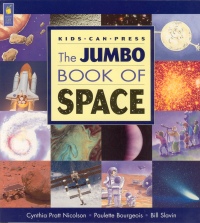| ________________
CM . . .
. Volume XIII Number 11 . . . .January 19, 2007
excerpt:
Written in question-and-answer format, this information-packed book provides answers to kids' commonly asked questions about the solar system. There are 18 main chapters whose topics cover the planets, the moon, the sun, space travel, stars, comets, asteroids and meteorites, the possibility of life on other planets, and galaxies beyond the Milky Way. The information is current, as evidenced by the reference to Pluto, which, after some controversy, was named a "dwarf planet" in 2006. There is one slight discrepancy in the information: in one part of the book, it states that the sun will last for another 6 billion years, yet in another, the number is given as 5 million years (not that any of the readers will be around then). In addition to the questions and answers, each chapter includes an ancient legend or myth pertaining to the subject. For example, in the chapter about stars, there is a story from India which tells how the brightest star, Sirius, appeared in the sky. There are also fun and easy experiments to try. These step-by-step experiments can be done at home with materials that are readily available and with little or no parental supervision (if adult help is required, there is a cautionary note). Readers will be able to make a balloon rocket, an eclipse of the moon and find out why sunsets are red, just to name a few.
Highly Recommended. Gail Hamilton is a teacher-librarian in Winnipeg, MB.
To comment
on this title or this review, send mail to cm@umanitoba.ca.
Copyright © the Manitoba Library Association. Reproduction for personal
use is permitted only if this copyright notice is maintained. Any
other reproduction is prohibited without permission.
NEXT REVIEW |
TABLE OF CONTENTS FOR THIS ISSUE
- January 19, 2007.
AUTHORS |
TITLES |
MEDIA REVIEWS |
PROFILES |
BACK ISSUES |
SEARCH |
CMARCHIVE |
HOME |
